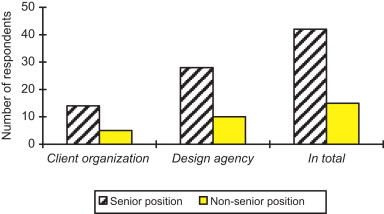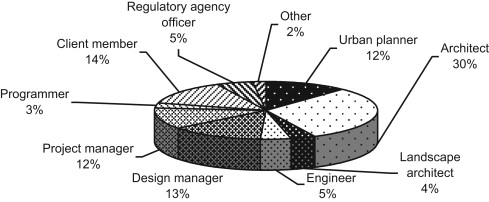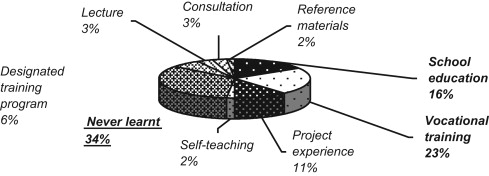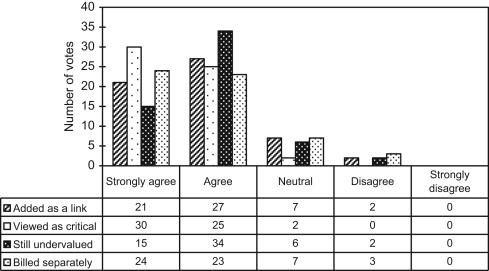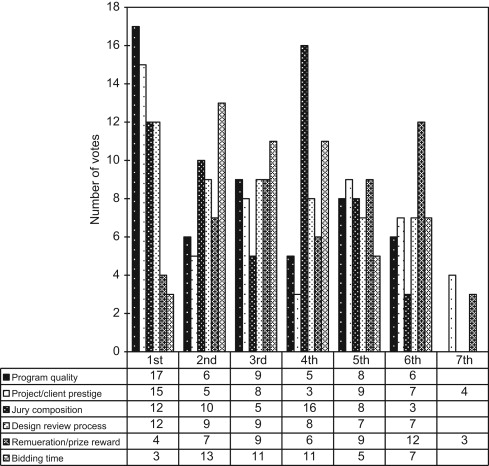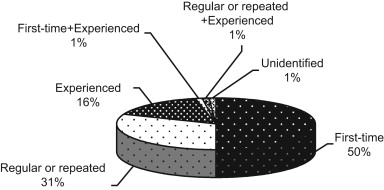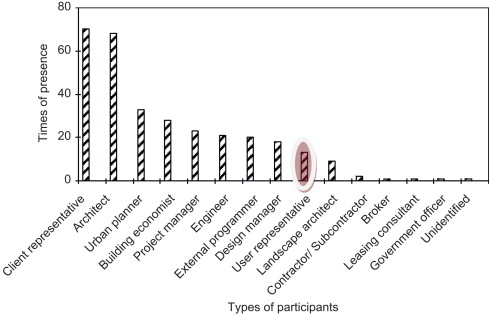Abstract
Chinas large public buildings (LPBs) often become problematic after only a few years' operation, leading to shortened building lifespans. Lacking architectural programming was identified by the industry regulators as a contributing factor to this. Despite a policy shift on the government side since 2007, little evaluation of the actual situation has been made. To raise awareness and attention to this pressing issue from the building industry, its regulators and the general public, a questionnaire survey focusing on the top-tier sector of professional practice in programming LPBs was carried out in Shanghai, China in 2009. The objectives were to evaluate current trends and pressing issues, identify major challenges and opportunities, and make recommendations for improvement. This paper presents a six-part analysis of the surveys findings from 57 professionals and clients who shared their hands-on experience on various programming issues and provided first-hand data of 90 LPBs developed in the 2000s. This pioneering study revealed significant gaps between the real and best practices as well as the mental reluctance and skill mismatch in delivering quality programming services. Given the persisting nature of identified problems, more research work should be done to catalyze a paradigmatic shift among industry players.
Keywords
Architectural programming ; The early stages ; Large public building (LPB) ; Questionnaire survey ; China
1. Introduction
1.1. Poor programming leads to short-lived buildings
In the wake of the late 2000s' global economic slowdown, Chinas stimulus program has triggered a significant upsurge in the construction sector. With a total expenditure of US$1 trillion, China overtook the United States as the worlds biggest construction market in 2010 (Betts et al., 2011 ). Despite an annual average of new construction up to 2 billion m2 or an equivalent of 40% of the worlds total, a buildings life span was only averaged about 35 years in China, lagging far behind 74 years in the United States and 132 years in the United Kingdom, according to the Ministry of Housing and Urban-Rural Development (MoHURD) (Qiu, 2010 ). This “ephemerality” phenomenon not only exist among those jerry-built residential buildings but already extend to many large public buildings (LPBs).
Chinas Ministry of Construction et al. (2007) defines LPBs as the buildings, each with a floor area of 20,000 m2 or above, which are used for any single or combined purposes of office, commerce, tourism, science, education, culture, health, communications, and transportation. A root cause for their shortened lifespans, as pointed out by MoHURD (2008) (the successor of the Ministry of Construction after 2007), was a lack of rigorous architectural programming as the critical first step of the early stages. Driven by the mindset to flaunt economic ascendancy through huge expenditure on image building, quite a number of LPBs across the country were overdesigned in form but under-designed in substance. As a result, many so-called landmarks easily become underuse, energy-intensive or even unsafe to use after only a few years in operation (Architecture Weekly, 17 March, 2008 ; Qiu, 2010 ). Despite exorbitant initial costs mainly on fancy facades and excessive decoration, less consideration was shown to fundamental building performance issues of spatial and functional integrity, user comfort, adaptability, economy, safety, energy efficiency, locality, and sustainability. The ignorance at the early stages may start a vicious cycle of frequent revamping, deconstruction and reconstruction after a building is occupied. This may explain why poor programming leads to short-lived buildings.
Just as a house built on an inadequate foundation will not last long, a building based on an incomplete program is seldom viable. In practice, this has been well received among the developed economies but not in China by far. Following the pioneering paper “Architectural Programming: Important Steps Before Design Can Begin” (Peña and Good, 1967 ), the significance of architectural programming has been generally realized by the industry and well researched by the academia in North America and Europe. For instance, extensive programming efforts must be made before undertaking and commissioning architectural design for large and complex building projects in most states of the United States. This has in turn encourage large American design practices to foster strong in-house capacities and close ties with professional programmers (Preiser, 1993 ). Similar regulatory mechanisms and codes of practice have been implemented long in the United Kingdom although laden with many practical problems (Blyth and Worthington, 2010 ; Kamara and Anumba, 2001 ). By contrast, there was a long interval before the term architectural programming was translated into Chinese in the 1990s. Except for the first domestic publication on architectural programming by Zhuang (2000) , related overseas literature in its original or translated versions was rare in China in the meantime. Domestic professional institutions also lacked focused efforts to promote this emerging concept and benchmark best practices, lagging behind their overseas counterparts such as American Institute of Architects, Royal Institute of British Architects and Australian Institute of Architects.
1.2. Police shift
As a good public building has to serve good to the public (Nasar, 1999 ), it becomes an imperative for Chinas building industry to increase the number of quality built products rather than the volume of new construction alone. The international focus on building sustainability, in particular, energy and economic resources management, has put on a new challenge on the building industry besides the traditional emphasis on quality, safety and environment. To curb the proliferation of problematic LPBs, a range of regulatory changes were jointly initiated in 2007 by the Ministry of Construction and four other related state ministries (2007). A tougher control was imposed over the number, scale and quality of LPBs. Moreover, MoHURD (2008) updated The provisions of schematic design tendering for construction projects , calling for substantial rectification in the following aspects of the entire design tendering process:
- The inclusion of detailed expert reports concerning a buildings functional performance, energy efficiency, construction and operational costs in the design bidding documents.
- The involvement of interdisciplinary experts in the design review process.
- A tougher control over the launching of international design competitions to avoid unnecessary pursuit of signature architecture.
- The inclusion of public consultation to enhance the transparency in the decision-making process.
Table 1 summarizes the best practice at the early stages of LPBs advocated in the above two government instructions. Despite a good starting point for a long overdue correction, little research has been carried out to probe into the real professional practice in programming LPBs and to map out the actual situation at large. Built upon such evidence-based findings, specific coping strategies with operational guidelines can be formulated for consideration by the government regulators.
| Issues at the early stages | The best practice |
|---|---|
| Clients program | The client shall seek experts' advice, clarify project requirements, and determine critical technical and economic parameters. |
| Schematic design | The schematic design shall conform to approved master plan, detailed regulatory plan of the specific site, and urban design of the site. |
| Format of design competition | Domestic rather than international design competitions shall be the first choice for clients. |
| Review of design competition | Open and transparent procedures shall be devised for the process, while the requirements and accountability of jury shall be clarified. |
1.3. Aim and objectives
The main thrust of this paper was to raise awareness and attention to this pressing issue by stakeholders of the building industry and the general public who are bonded by their common interests in LPBs. To this end, a questionnaire survey on the professional practice in programming LPBs developed in the 2000s was conducted in Shanghai, China in 2009. Specific objectives of this explorative study were to evaluate the current trends and issues; identify related challenges and opportunities; and promote the needed consensus on formulating a way forward among the government regulators, professionals and scholars.
Given the time, physical and financial constraints, it was deemed realistic to keep clarity and focus by starting with representative individuals and organizations in the top-tier sector of LPBs, i.e., those with significant impacts on the local and national scales. This was based on a simple rationale: if the professional practice sampled from the specific “high-end stratus” with more regulated clients and better qualified professionals is problematic as against the best practice, it will be more confident to predicate more problems in the rest “strata” and infer the magnitude of the issue at large.
2. Research framework
The rest of this paper is structured in three parts. The research framework is first introduced in terms of its theoretical background, method and design, selection criteria, and data collection. This is followed by a six-part presentation of the surveys major findings. Finally, conclusions are drawn and recommendations made to the industry and its regulators.
2.1. Theoretical background
A buildings lifecycle can be mainly phased into the early stages and the later stages as shown in Table 2 . Although research findings continue to prove well-informed early stages lead to well-performed buildings, the input at the early stages remains significantly lower than that at the later stages in practice (Barrett and Stanley, 1999 ; Best and Valence, 1999 ; Smith et al ., 2001 ; Smith, 2003 ; Vanston, 2003 ). As an initial step towards a buildings lifecycle and an integral component of the early stages, the process of programming (briefing) allows all stakeholders to assess opportunities and constraints, investigate and communicate requirements, and develop a program statement as the guidance of a proper design solution and as a constant yardstick against the built product (Hershberger, 1999 ; Kumlin, 1995 ; Peña and Parshall, 2001 ). A program is a set of documents that explicitly clarifies the objectives, existing contexts, philosophies and functional requirements of a project to facilitate design decision making (Preiser, 1993 ). An important attribute of a program is that it never remains static but is subjected to constant validation by the client organization and its understanding of external demand (Best and Valence, 1999 ).
| No. of sub-stages | The early stages | The later stages | ||||
|---|---|---|---|---|---|---|
| Three | Brief and design | Construction planning | Construction | |||
| Pre-design | Design | Post-design | ||||
| Feasibility | Pre-construction | Construction | ||||
| Programming | Designing | Building (execution) | ||||
| Pre-project (briefing) | Project (design and construction) | Post-project (review ) | ||||
| Appraisal | Implementation | Operation | ||||
| Four | Programming | Design | Construction | Occupancy | ||
| Appraisal | Design | Construction | Operation | |||
| Five | Program development | Preliminary design | Production | Construction | Post-occupancy | |
| Concept | Briefing | Planning | Production | Evaluation | ||
| Preparation | Design | Pre-construction | Construction | Management | ||
| Concept | Development | Implementation | Termination | Operation, maintenance | ||
| Concept | Definition | Production | Operation | Divestment | ||
| Briefing | Designing | Tendering | Constructing | Commissioning | ||
| Planning | Programming | Design | Construction | Occupancy | ||
| Six | Programming | Schematic design | Design development | Construction documents | Construction | Occupancy |
Sources : complied from ( Austen and Neale, 1984 ; Best and Valence, 1999 ; Bowen et al ., 1997 ; Carmichael, 2006 ; Cherry, 1998 ; Cherry and Petronis, 29 November, 2005 ; Cleland and Ireland, 2007 ; Hershberger, 1999 ; Ryd, 2004 ).
A large and complex building project may also include the preliminary/schematic design phase (Table 2 ). According to MoHURD (2008) , an open or invited architectural competition is compulsory for any LPBP in China, unless otherwise specified. As a key approach to procuring quality building products, design competitions can be categorized into several basic formats and developed into more combined options (Table 3 ). As an important vehicle between the competition sponsor (usually the client) and the competitors, a competition program serves as an important vehicle to clarify the clients requirements, define terms of reference for the competitors, and provide yardsticks for the jurys evaluation of the competition entries (American Institute of Architects, 1988 ; RAIA, 2003 ).
| Aspects of consideration | Types of competition |
|---|---|
| Eligibility of competitors | Open |
| Limited/selected | |
| Scope of the competition | International |
| National | |
| Regional | |
| Objective of the competition | Idea |
| Project | |
| Scale and complexity of the project | One-stage |
| Two-stage | |
Sources : American Institute of Architects, 1988 ; Nasar, 1999 ; RAIA, 2003 .
2.2. Research method and design
The method of questionnaire survey, due to its extensive use in programming research worldwide [e.g., (Bowen et al ., 1997 ; Brown, 2001 ; Kelly et al ., 2005 ; Preiser, 1993 ; Shen and Chung, 2006 )], was employed for this experimental study in China. Based on these previous studies, three interrelated common issues were identified. Firstly, intensive client involvement in establishing a good program holds the key to the quality of design service (Barrett and Baldry, 2003 ), but the issue of a client organization is often ignored or oversimplified (Boyd and Chinyio, 2006 ). Secondly, organizational issues rather than methodological issues arising from the client organization might exert greater impacts on the outcome of a project, but were largely ignored in the programming process (Farbstein, in Preiser, 1993 , p. 384). Finally, for a large and complicated project, it is difficult to determine the components of its programming team in practice (Kumlin, 1995 ). These formed part of the focal issues considered in the survey. The questionnaire was structured in six parts containing 26 questions—among which 14 (54%) are closed ended, 10 (38%) are semi-closed ended, and the rest two (8%) open-ended (Table 4) .
| Aspect of concern | Scope of inquiry |
|---|---|
| Part 1 (Q1–7) |
|
| Respondent profile | |
| Part 2 (Q8–14) |
|
| Programming performance | |
| Part 3 ( Q15–18) | Whether do respondents agree the following statements:
|
| Awareness on programming | |
| Part 4 (Q19–20) |
|
| Design competition and its programs | |
| Part 5 (Q21–25) |
|
| Formation of a program | |
| Part 6 (Q26) |
[location, type, scale, attribute (regular or event-led), length of formation period].
|
| Programming cases | |
2.3. Sampling techniques
A few sampling techniques, i.e., cluster sampling, stratified sampling, convenience sampling and snowball sampling were used in combination (Groves, 2002 ), to better focus on the target group and yield more valid and accurate results in a timely and cost-effective manner.
- Cluster sampling was employed to determine Shanghai as the initial survey base for several reasons. Normally, an international metropolis has a better chance than other less internationalized cities to attract and accommodate major developments. Shanghai fits the profile due to its reputation as one of the most developed markets for LPBs in China and its global perspective and all-inclusive capacity to attract diversified resources.
- There were several reasons to use stratified sampling. Among others the construction of major building flagships led by Expo 2010 served as a big boost for an influx of domestic and overseas industrial players into the city since 2001. This would facilitate the selection and liaising of respondents of different natures. A number of high-profile international design competitions were launched by several well-established local developers between 2004 and 2007. The shortlisted design agencies were invited mainly for their extensive experience and track record in handling large and complex building projects in China and overseas. The highly strict screening processes of design tendering indicated that the clients and designers selected from a large pool of qualified candidates at the local, regional and international levels would be representative of the top-tier players in LPBs as the targeted subgroup. Hence, this group of respondents were considered as the most suitable “stratus” for this explorative study.
- As convenience sampling is most useful for pilot testing (Fink, 1995 ), the first authors work experience in both the professional and government sectors of Shanghai between 2003 and 2007 offered another bonus in the process of liaising with the target respondents.
- Snowballing sampling were used when some initially approached respondents agreed to refer more potential respondents whom they considered capable of answering the questionnaire due to their job nature and work experience.
2.4. Selection criteria
Three major criteria were set out for selecting respondents as follows:
- The inclusion of client organizations . Unlike some previous surveys aiming solely at professional consultants such as architects, key client members as the driving force of the early stages were also included. The inclusion of design consultants of various nature and their clients allowed pressing issues highlighted in the two government documents mentioned earlier to be explored more completely.
- The capacity of design agencies . Due to the highly selective nature of the procurement processes for major LPBs, design contracts are usually awarded to a limited number of large and interdisciplinary practices experienced in handling sophisticated design tasks. It hence made sense to seek respondents from these agencies.
- The capacity of respondents . To ensure the validity and accuracy of first-hand data, preference was given to those potential respondents with both decision-making authorities and enriched experience at the early stages of LPBs.
2.5. Data collection
The questionnaire sheets were prepared in Chinese and English versions to suit different needs. In January 2009, the hardcopies of 70 questionnaire sheets were distributed to each available respondent in Shanghai. Subsequently, 30 electronic copies were emailed to other intended respondents who were previously unavailable in Shanghai. Altogether 100 questionnaire sheets were sent to potential respondents in 11 qualified large agencies, including three Shanghai-based public clients and eight large design practices. Among the three local clients, one was from the government sector and the other two from the business sector. All were actively involved in a number of high-profile LPBs including major building flagships for Expo 2010. Among the eight large design practices, five were based in Beijing and Shanghai and listed on The Top 60 Chinese Design Firms for 2008 (ERN, 2009b ), with one ranked in the top five and two in top 20. The three overseas firms were also ranked among The Top 500 US-based Design Firms for 2008 (ERN, 2009a ). All eight firms had extensive experience in designing major LPBs in major Chinese cities. By the end of March 2009, 65 replies (65% response rate) in hardcopy or electronic version were returned, among which 57 were regarded as valid and the rest eight were incomplete. Follow-up enquires for more detailed explanations or clarifications to the completed questionnaires were made afterwards.
3. Major findings
In line with the framework set out above, major findings are reported in six parts below.
3.1. Profiles of respondents
Each of the 57 respondents was involved in at least one LPBP between 2003 and 2009. Respondents' profiles were studied in five aspects as specified in Table 4 . Figure 1 shows that 74% respondents held senior positions at the time of the survey. Six respondents (11%) claimed to have been handling 50 to over 100 LPBs. Figure 2 indicates the distribution of respondents by occupation or speciality. Figure 3 demonstrates that 66% received certain type of programming-related education or training, while 34% never did. In terms of the source, 16% received programming-related education from school education while 23% obtained the knowledge from vocational training.
|
|
|
Figure 1. Distribution of respondents by position. |
|
|
|
Figure 2. Respondents distribution by job title/specialty. |
|
|
|
Figure 3. Distribution of programming learning channel (person-time). |
3.2. Professional practice in programming LPBs
Part 2 examines the supply-demand trends and the academic and educational provision in architectural programming. Most respondents (89%) agreed that the demand for programming services was “on the rise” and the future market would be “promising”. However, 58% thought that there was a lack of quality professional services. Almost unanimously, 95% and 96% considered that the provision of related literature and education was insufficient. To further understand the impacts of programming on the later stages, respondents were asked to rank five possible consequences closely tied to the programming process. Figure 4 ranks them by number of votes each problem received. The result showed “major design revision” ranking in the first place, followed by “outstanding cost overrun”, “serious operational problem”, “serious cooperation problems” and “serious construction delay”.
|
|
|
Figure 4. Ranking of programming-related consequences. |
3.3. Awareness on programming
To investigate the awareness on programming among different industrial players, opinions were sought regarding the value, status and fee of programming. As listed below, the four statements were given for the correspondents' evaluation. Detailed results illustrated in Figure 5 indicated that 87% of respondents supported all four statements as a whole.
| Traditionally speaking, the whole project cycle in the Mainland China can be roughly phased into planning, design, construction and occupancy. Do you think programming should be added as a connection link between planning and design? |
|
| Do you think the process of programming is critically important to the whole project cycle? |
|
| Do you think programming is still undervalued in the Mainland Chinas construction industry? |
|
| Do you think there should be a separate fee for the programming service provided by professionals besides the routine billing system? |
|
|
|
|
Figure 5. Awareness of programming. |
3.4. Design competition and its program
This part includes the following two questions for respondents to rank:
- An open design competition is compulsory for a large-scale public building as stipulated by the relevant law. According to your own experience, how will the following factors affect the competition outcome? Please rank the applicable items in number by order of priority (e.g., 1-most important, 10-least important).
- Project/client prestige
- Remuneration/prize money
- Jury composition
- Length of the tendering time
- Design review process
- Program quality
- Other
- A competition program serves as both the primary vehicle for a design competition and the fundamental criteria for evaluating competition entries. Have you encountered, or have been given feedback on, any of the following problems in a competition program for a large-scale public building project? Please rank the applicable items in number by order of priority (e.g., 1-most important, 10-least important).
- Lack of site suitability or adequacy
- Ignorant of, or in conflict with regulatory planning requirements
- Too generic or too trivial in project requirements
- Lack of priority, clarity or consistency in the occupancy requirements
- Only a space list, lack of specificity of the clients idiographic values and objectives
- Unachievable budget or inadequate cost estimation
- Unachievable project schedule
- Insufficient required gross floor area (GFA) resulted from miscalculation or inconsideration of net-to-gross
area ratios of different building types
- Other
For the first question, accordingly to the number of votes illustrated in Figure 6 , the first-choice ranking is as follows:
- 1 “Program quality”
- 2 “Project/client prestige”
- 3 “Jury composition
- 3 “Design review process”
- 4 “Remuneration/prize reward”
- 5 “Bidding time”
|
|
|
Figure 6. Ranking of factors affecting the outcome of a design competition. |
For the second question, by order of the first-choice, eight most frequent problems are:
- Too generic or too trivial in project requirements.
- Lack of priority, clarity or consistency in the occupancy requirements.
- Lack of site suitability or adequacy.
- Ignorant of, or in conflict with regulatory planning requirements.
- Only a space list, lack of the clients idiographic values and objectives.
- Unachievable budget or inadequate cost estimation.
- Insufficient gross floor area by the client resulted from miscalculation or inconsideration of net-to-gross area ratios of different building types.
- Unachievable project schedule.
3.5. Formation of the program
When asked whether the professionals should provide assistance to their clients at the programming stage, an overwhelming majority (91%) responded positively. Among the three given reasons, 81% respondents agreed that by doing so, it could realize the objective to “better determine the clients requirements to assure design efficiency and quality”; while 53% considered this could “build up a long-term reciprocal relationship with the client” and “help win the trust and respect from the client, thus having greater say in the process of design decision making”. With regard to the issue of programming methods, the ranking of six given choices by order of popularity is shown in Figure 7 . “Study visit” was on the top while “literature search” ranked at the bottom. About 2% respondents chose their own ways including external consultations of governmental or professional agencies, market analysis, multiple-scheme comparison and selection.
|
|
|
Figure 7. Frequency of programming methods in use. |
Interestingly, both similar and contradictory results were recorded in this survey and the Preisers (1993) . In both cases, “literature search” was ranked the lowest in actual usage. The insufficient provisions in research and education in China partially explained its unpopularity in this survey. Furthermore, “study visit to similar projects” ranked the most popular method in this survey but the least popular in Preisers (1993) . A possible explanation for this is that, in China, such visits are normally arranged by the clients and their designers together after the awarding of design contracts. These field trips can provide good opportunities for the clients to get a feel of those built products of similar nature by seeing, walking around and listening to the opinions from the current users and facility managers or even the original consultants and project managers. In turn, the designers are also able to better understand their clients' requirements and preference with the presence of real built products. The mutually beneficial nature of this method may also help strengthen the client-designer relationship at the early stages.
3.6. Programming cases
To identify pressing challenges faced by the current practices, the questions in the last part of the survey were designed to draw out information on LPBs with respondents' own inputs. The 90 projects provided by respondents were mainly developed between 2000 and 2009. They were located in 25 mega- and medium-cities, among which 65% came from four municipalities—Beijing, Tianjin, Shanghai and Chongqing. Many projects were high-profile on local, national or international scales. About one third of the 90 projects were led by various events including the Beijing 2008 Olympics and the Shanghai 2010 Expo. New construction, conversion and extension accounted for 79%, 12% and 9% respectively. Those with a total floor area of 50,000 m2 or above accounted for 74%. Sixteen types of LPBs were recorded, among which 56% were mixed-use, ranging from two to four combinations of the basic types in the official definition of LPBs. Among the 90 projects, government and corporation clients accounted for 97% in the 90 projects. Half of the LPBs were developed by first-time clients, while 47% were either developed by either experienced or regular/repeated clients (Figure 8 ). With regard to organizational structure, 81% clients were single-headed and 19% multiple-headed. Eight-eight projects (98%) were procured through design competitions, among which 64% were invited competitions. International and domestic competitions almost equaled each other in the 88 cases.
|
|
|
Figure 8. Distribution of the 90 surveyed LPBs by nature of clients. |
In terms of the billing issue of programming, about 30% of the 90 programming services were billed, either as part of the design service or as a separate consulting service. This was in sharp contrast with the result that 82% respondents supported the institutionalization of billing the programming service separately. The division indicated that programming was still undervalued by the market. In terms of the composition of the programming team, Figure 9 reflects the ranking of its members by frequency of presence. Results show that “Client representative” (78%) came in the first place, while “Architect” (76%) scored much higher than other professionals such as urban planner, Building economist and Engineer. Worth noting is that “User representative” ranked fairly low at a 14% presence rate.
|
|
|
Figure 9. Ranking of programming team members by frequency of presence in the 90 surveyed LPBs. |
4. Discussions and conclusions
This explorative questionnaire survey revealed some significant gaps between the best and real practices in programming LPBs. The results are summarized in Table 5 . Furthermore, the following three findings also deserve due attention from the industry as well as its regulators.
- Fee issue . Seventy percent of programming services were not paid in the 90 LPBs under survey; suggesting much fewer clients were willing to pay the bill, no matter how insignificant the amount can be. This reality check posed an interesting contrast to another finding that most respondents acknowledged the significance of programming.
- User participation . The result showed that user representatives were much less involved in the programming process than eight out of 14 identified types of participants. Coupled with the lack of post-occupation evaluation mechanism, this might partially explain why a significant portion of LPBs, according to the MoHURDs report (2008), did not function well beyond only a few years of operations.
- Demand-supply mismatch . The survey also revealed a shortage of well-trained professionals to provide quality programming services. Although perceived as a growth area by most respondents, conventional wisdom still holds that it would not necessarily attract monetary rewards in practice. A fundamental reason was that that there appeared no real incentive to encourage the professionals to enhance their performances given the current non-profitable nature of programming services.
| Issues in the early stages | The best practice | The real practice |
|---|---|---|
| Clients program | The client shall seek experts' advice, clarify project requirements, and determine critical technical and economic parameters. | The top two ranked problems in a competition program: |
| ||
| Schematic design | The schematic design shall conform to approved master plan, detailed regulatory plan of the specific site, and urban design of the site. | The 3rd and 4th ranked problems of competition programs: |
| ||
| Format of design competition | Domestic rather than international competitions shall be the first choice for clients. | Actual ratio between international and domestic competitions was 48%: 51%. |
| For highest profile design competitions, international competitions have become a norm. | ||
| Review of design competition entries | Open and transparent procedures shall be devised for the process, while the requirements and accountability of jury shall be clarified. | There was a lack of a clearly-defined review procedure and evaluation criteria in the competition program. |
Despite the imposing of tougher regulations from the government side since 2007, feedback from a predominant majority of respondents in 2009 suggested that the industry still reacted with skepticism about the feasibility of the advocated best practice. According to the surveys results, programming services for LPBs were underpaid and undervalued among the surveyed top-tier industry players. There appeared virtually no incentive to challenge the conventional wisdom that the designing process, rather than the programming process, would more easily bring a sense of achievement and more concrete rewards to both the clients and professionals. This would certainly discourage the clients from giving more considerations to the user requirements or prevent the professionals from investing more in providing quality programming services. Although it was not the intention of this small-scale survey to cover all issues of programming LPBs in China, an important message conveyed here is that an effective mechanism for catalyzing a mentality shift among industry players has to be worked out apart from a policy shift from the government sector.
Given the multidimensional impacts of programming on the long-term performances of LPBs and the capacity shortfalls in delivering quality programming services among professionals, it becomes imperative to develop a concrete package of implementation tools to translate the desirable aims into clearly measurable rules and regulations. In view of the persisting nature of the problems identified, more broader-scale work needs to be carried out to help the government regulators to better understand the real picture of professional practice and to formulate effective incentives and action plans to develop the industrys related capacities. Such research will facilitate the comparison between the current practices in China and international best practices and the identification of the most concentrated problem areas. Based on these accumulative studies, specific benchmarks and measures in delivering quality programming services can be set out for trial implementation in major cities under pilot programs to check and improve feasibility and efficiency by the government regulators. This would eventually accelerate the desired paradigmatic shift in the whole industry. By then, professionals and clients will be more willing to invest time and efforts in better programming towards more responsible and sustainable LPBs.
Acknowledgements
The authors are deeply grateful for the generous support and invaluable inspiration for this survey from respondents and referees amid their extremely busy agendas.
References
- American Institute of Architects, 1988 American Institute of Architects.1988. Handbook of architectural design competitions, 15th ed.. Washington, DC: American Institute of Architects
- Architecture Weekly, 17 March, 2008 Architecture Weekly, 17 March, 2008. F4, for arts or for luxury? Architecture Weekly, p. 4. Available from: 〈http://www.archweekly.com〉 .
- Austen and Neale, 1984 A.D. Austen, R.H. Neale (Eds.)International Labour Office, Geneva (1984)
- Barrett and Baldry, 2003 P. Barrett, D. Baldry; Facilities Management: Towards Best Practice; (2nd ed.)Blackwell Science, Oxford, UK; Malden, MA (2003)
- Barrett and Stanley, 1999 P. Barrett, C. Stanley; Better Construction Briefing; Blackwell Science, Oxford (1999)
- Best and Valence, 1999 R. Best, G.D. Valence (Eds.)John Wiley, London; New York Arnold (1999)
- Betts et al., 2011 Betts, M., Robinson, G., Blake, N., Burton, C., & Godden, D., 2011. Global Construction 2020. Global Construction Perspectives and Oxford Economics, London.
- Blyth and Worthington, 2010 A. Blyth, J. Worthington; Managing the Brief for Better Design; (2nd ed.)Routledge, New York, NY (2010)
- Bowen et al., 1997 Bowen, P.A., Pearl, R.G., Nkado, R.N., Edwards, P.J., 1997. The Effectiveness of the Briefing Process in the Attainment of Client Objectives for Construction Projects in South Africa. Paper Presented at the COBRA'97, RICS Research Conference, University of Portsmouth.
- Boyd and Chinyio, 2006 D. Boyd, E. Chinyio; Understanding the Construction Client; Blackwell, Oxford, Malden, MA (2006)
- Brown, 2001 S.A. Brown; Communication in the Design Process; Spon Press, London (2001)
- Carmichael, 2006 D.G. Carmichael; Project Planning, and Control; Taylor & Francis, London; New York (2006)
- Cherry, 1998 E. Cherry; Programming for Design: From Theory to Practice; John Wiley, New York (1998)
- Cherry and Petronis, 29 November, 2005 Cherry, E., Petronis, J., 29 November, 2005. Architectural Programming. Available from: 〈http://www.wbdg.org/design/dd_archprogramming.php〉 (accessed 20.10.07.).
- Cleland and Ireland, 2007 D.I. Cleland, L.R. Ireland; Project Management: Strategic Design and Implementation; McGraw-Hill, New York (2007)
- ERN, 2009a ERN, 2009a. The top 500 US-based design firms for 2008. Available from McGraw-Hill Companies, Inc. 〈http://enr.construction.com〉 (accessed 07.06.09.).
- ERN, 2009b ERN, 2009b. The Top 500 US-based Design Firms for 2008. Available from McGraw-Hill Companies, Inc. 〈http://enr.construction.com〉 (accessed 07.06.09.).
- Fink, 1995 A. Fink (Ed.), How to Sample in Surveys, vol. 6, Thousand Oaks, Calif.: Sage Publications (1995)
- Groves, 2002 R.M. Groves (Ed.)Wiley, New York (2002)
- Hershberger, 1999 R. Hershberger; Architectural Programming and Predesign Manager; McGraw-Hill, New York (1999)
- Kamara and Anumba, 2001 J.M. Kamara, C.J. Anumba; A Critical Appraisal of the Briefing Process in Construction; Journal of Construction Research, 2 (1) (2001), pp. 13–24
- Kelly et al., 2005 J. Kelly, K. Hunter, G. Shen, A. Yu; Briefing from a facilities management perspective; Facilities, 23 (7/8) (2005), pp. 356–367
- Kumlin, 1995 R.R. Kumlin; Architectural Programming: Creative Techniques for Design Professionals; McGraw-Hill, New York (1995)
- Ministry of Construction of PRC et al., 2007 Ministry of Construction of PRC, National Development and Reform Commission of PRC, Ministry of Finance of PRC, Ministry of Supervision of PRC, National Audit Office of PRC, 2007. Several Opinions on Enhancing the Administration of Large-Scale Public Building Project Construction. Ministry of Construction of the Peoples Republic of China. Available from: 〈http://www.gov.cn/gzdt/2007-01/11/content_492868.htm〉 .
- Ministry of Housing and Urban-Rural Development of PRC, 2008 Ministry of Housing and Urban-Rural Development of PRC, 2008. Administrative Measures of Architectural Schematic Design Tendering for Building Projects, Beijing, p. 63. Available from: 〈http://www.mohurd.gov.cn/zcfg/jswj/jzsc/200804/t20080402_158921.htm〉 .
- Nasar, 1999 J.L. Nasar; Design by Competition: Making Design Competition Work; Cambridge University Press, Cambridge; New York (1999)
- Peña and Parshall, 2001 W.M. Peña, S. Parshall; Problem Seeking: an Architectural Programming Primer; (4th ed.)Wiley, New York (2001)
- Peña and Good, 1967 W.M. Peña, L.V. Good; Architectural programming: important steps before design can begin; Junior College Journal: The Magazine for Junior College Education, American Association of Junior Colleges (1967), pp. 34–37
- Preiser, 1993 W.F.E. Preiser (Ed.)Van Nostrand Reinhold, New York (1993)
- Qiu, 2010 Qiu, B.-X., 2010. Outlook of Chinas six fields with the biggest potential for energy-conservation. Paper Presented at the the Sixth International Conference on Green Building and Building Energy-Conservation, Beijing 〈http://www.cin.gov.cn/ldjh/jsbfld/201004/t20100408200306.htm〉 .
- RAIA, 2003 RAIA, 2003. Guidelines for Architectural Design Competitions. Available from: 〈http://www.architecture.com.au/〉 (accessed 19.11.10.).
- Ryd, 2004 N. Ryd; The design brief as carrier of client information during the construction process; Design Studies, 25 (3) (2004), pp. 231–249 http://doi.org/10.1016/j.destud.2003.10.003
- Shen and Chung, 2006 G.Q.P. Shen, J.K.H. Chung; A critical investigation of the briefing process in Hong Kongs construction industry; Facilities, 24 (13/14) (2006), pp. 510–522
- Smith et al., 2001 J. Smith, P.E.D. Love, R. Wyatt; To build or not to build? Assessing the strategic needs of construction industry clients and their stakeholders; Structural Survey, 19 (2) (2001), pp. 121–132
- Smith, 2003 N.J. Smith (Ed.)Thomas Telford, London (2003)
- Vanston, 2003 J.H. Vanston; Better Forecasts, Better Plans, Better Results; Research-Technology Management (2003), pp. 47–58
- Zhuang, 2000 W.M. Zhuang; Guide to Architectural Programming; (1st ed.)Water Power Press, Beijing, China (2000)
Document information
Published on 12/05/17
Submitted on 12/05/17
Licence: Other
Share this document
Keywords
claim authorship
Are you one of the authors of this document?
